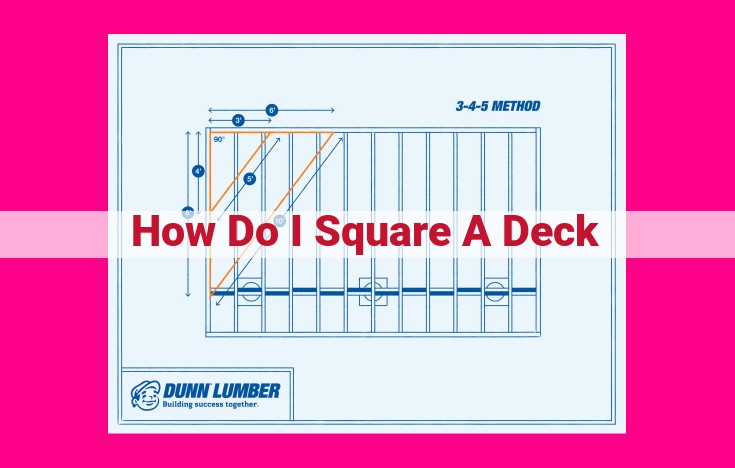Square Your Deck: Step-By-Step Guide To Precision Installation

To square a deck, use a framing square to ensure the corners are 90 degrees, measuring diagonally from opposite corners to ensure they are equal. Install deck boards perpendicular to the joists by marking perpendicular lines using a chalk line. Use a level to ensure the frame and boards are level.
Essential Tools for Building a Deck: Precision and Efficiency
Embarking on the exciting journey of deck construction requires an arsenal of essential tools to ensure precision and efficiency. The foundation of a sturdy deck lies in the accuracy of measurements and the flawless execution of cuts. Let’s delve into the must-have tools that will empower you to create a beautiful and long-lasting outdoor oasis.
Measuring Tools
Precision is paramount when it comes to deck construction. A trusty measuring tape is indispensable for precise measurements of deck boards, joists, and other components. A level ensures that the deck frame is perfectly level, preventing water accumulation and ensuring stability. Squares and framing squares are vital for squaring the deck frame, ensuring that the corners are perfectly perpendicular, and for marking angles for cuts.
Cutting Tools
The right cutting tools are essential for precise cuts and smooth edges. A circular saw is a powerhouse for cutting long, straight cuts in deck boards and joists. A jigsaw is perfect for intricate cuts and curves, such as around obstacles or for creating decorative cutouts. Always wear appropriate safety gear when using cutting tools.
Other Essential Tools
Beyond the core measuring and cutting tools, a few additional items will greatly contribute to the accuracy and efficiency of your deck build. A chalk line is invaluable for marking straight lines for cutting deck boards and aligning joists. Clamps are essential for holding pieces together securely while assembling the deck frame and installing deck boards. They ensure a tight fit and prevent shifting, resulting in a sturdy and long-lasting deck.
Essential Techniques for Ensuring Accuracy in Deck Construction
Squaring the Deck Frame
Laying the foundation of your deck begins with ensuring its accuracy. Two foolproof methods guarantee a perfectly squared frame:
- Diagonal Measurement Technique: Measure the diagonals of the frame from opposite corners. If they’re equal in length, your frame is square.
- 3-4-5 Triangle Method: Form a triangle with three measurements: 3, 4, and 5 feet (or multiples thereof). Place the triangle’s corners on the frame’s perimeter, aligning the 3-foot side with a beam. If the 4- and 5-foot sides form a right angle, the frame is square.
Verifying Frame Squareness with Measuring Tools
Confirm the frame’s squareness using a square and a framing square. Place the square on the frame’s inside corners and the framing square on the outside corners. Ensure that both tools indicate a 90-degree angle at all points. This meticulous attention to detail will ensure the deck’s integrity and durability.
Installing Deck Boards for Precision
Installing deck boards perpendicular to the joists is crucial for a stable and aesthetically pleasing deck surface. Follow these steps:
- Mark the Joist Spacing: Use a chalk line snapped perpendicular to the joists to mark the spacing for each deck board.
- Secure the Boards: Nail or screw the first board into place, ensuring it’s flush with the end of the joist.
- Align Subsequent Boards: Use the chalk line as a guide to align the subsequent boards, ensuring they’re perfectly perpendicular to the joists.
- Secure Each Board: Nail or screw each board securely into place, checking for perpendicularity with a square or framing square throughout the installation process.
By employing these techniques, you’ll achieve an accurate and long-lasting deck that will enhance the beauty and functionality of your outdoor space.
Essential Materials for Deck Construction: The Building Blocks of a Solid Foundation
When embarking on the journey of building a deck, selecting the right materials is crucial for a stable and long-lasting structure. Understanding the roles and properties of each component ensures a solid foundation that will withstand the elements and provide years of enjoyment.
Structural Components: The Backbone of Your Deck
Deck Boards: These planks form the surface of your deck, bearing the weight of foot traffic and furniture. Choose durable materials like pressure-treated lumber, composite decking, or exotic hardwoods for optimal longevity.
Joists: Running perpendicular to the deck boards, joists provide structural support and distribute weight evenly. Select joists that are strong enough to meet building codes and withstand the intended loads.
Beams: The heavy-duty beams carry the joists and transfer the load to the support posts or footings. They require substantial strength and are typically made of pressure-treated lumber or engineered wood products.
Ledger Board: This crucial component connects the deck to the house or other structure. It anchors the beams and must be securely fastened to provide a stable foundation.
Supporting Materials: Ensuring Level and Precision
Shims: These thin, tapered pieces allow for precise leveling and adjustment of the frame. By inserting shims between the joists and beams, you can eliminate any unevenness and ensure a level surface for your deck boards.
Choosing the right materials for your deck construction is essential for a solid and reliable structure. By understanding the roles and properties of each component, you can make informed decisions that will ensure a deck that stands the test of time and enhances your outdoor living experience.